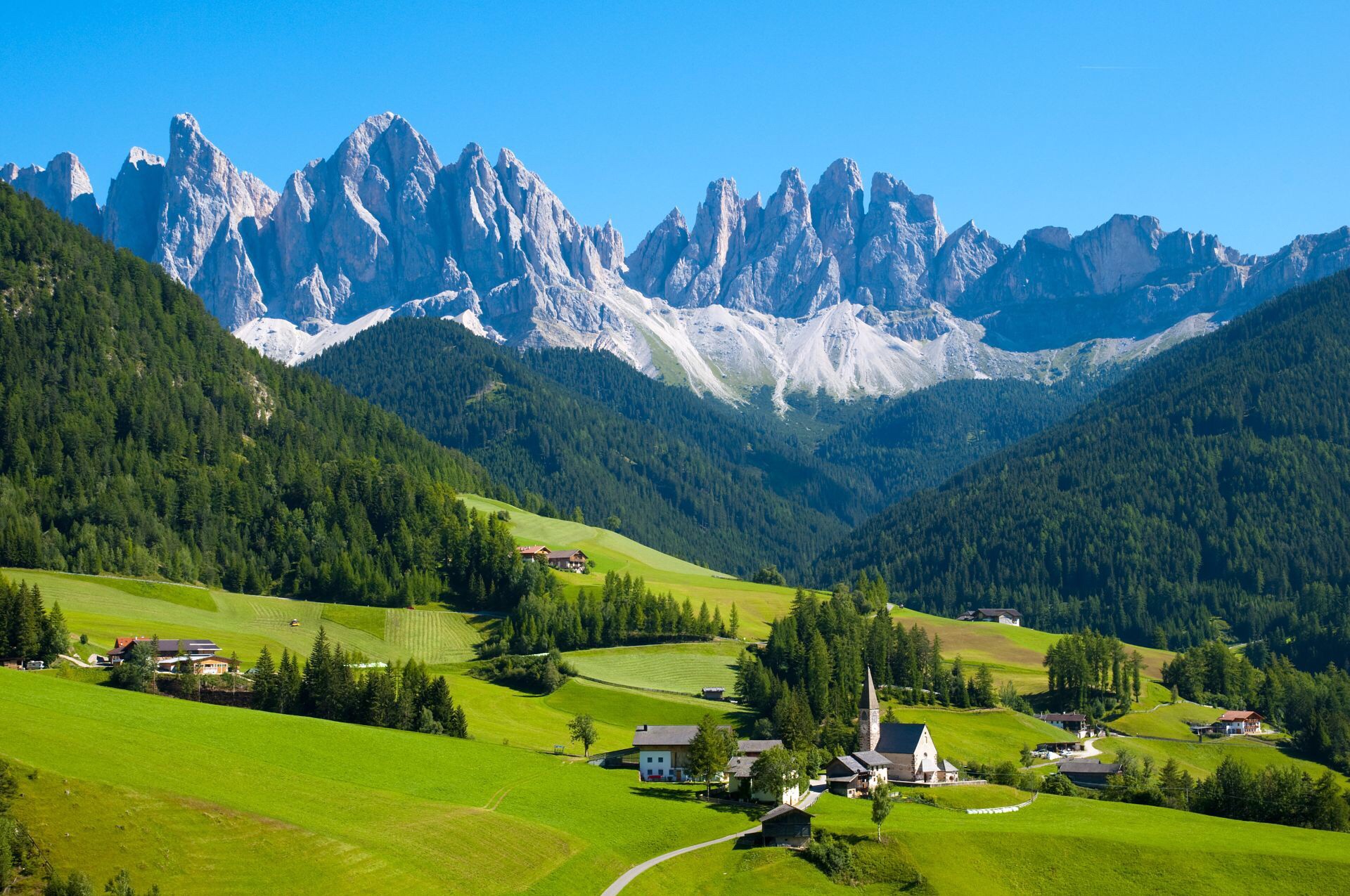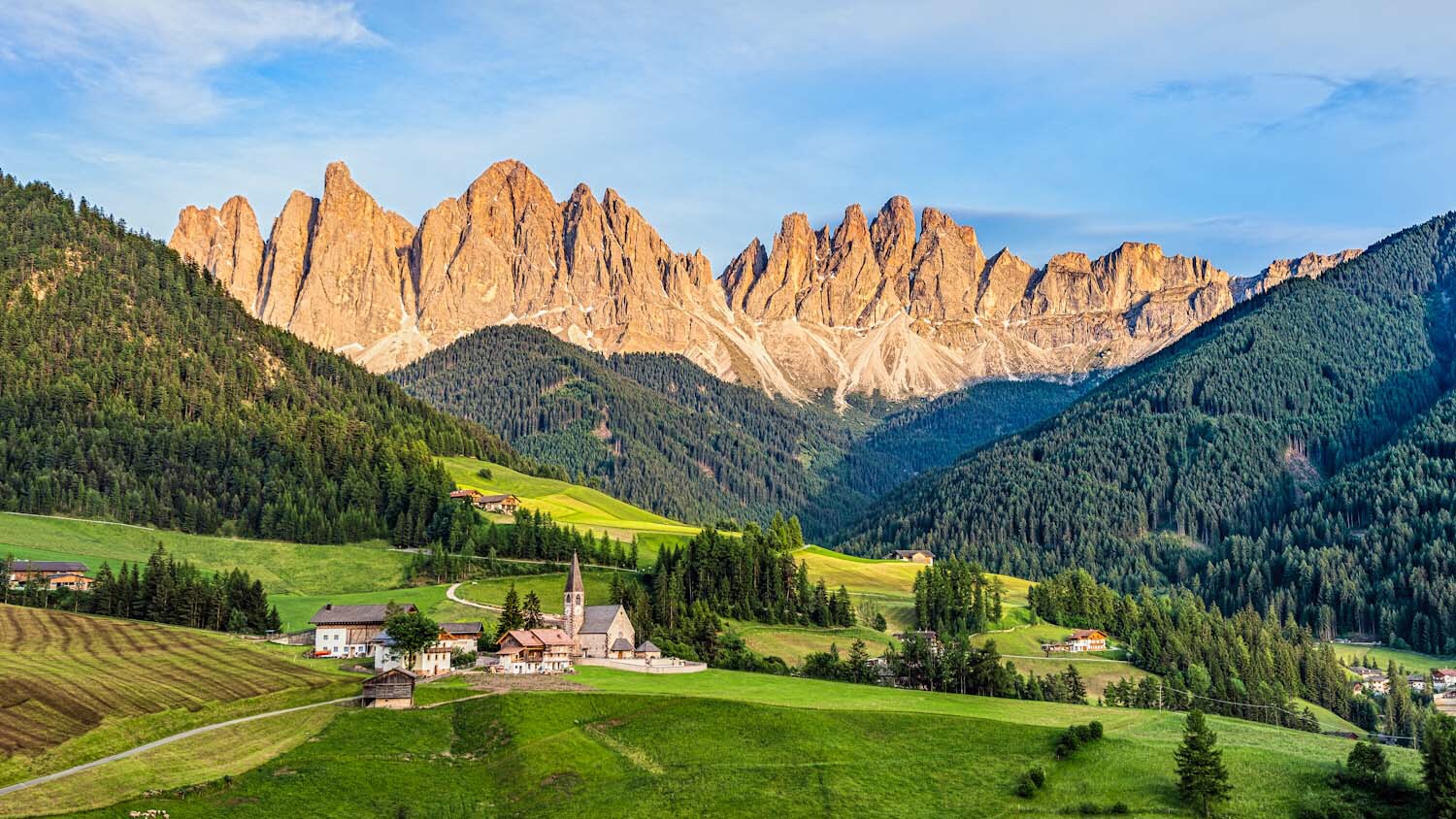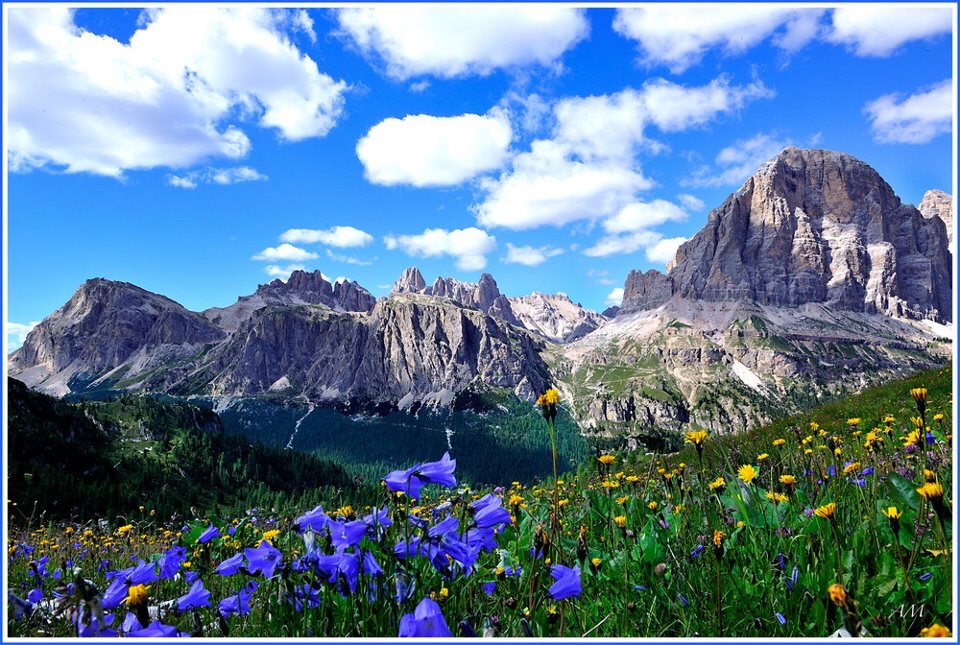

The Dolomites are a mountain range located in north-eastern Italy. They form a part of the Southern Limestone Alps, which in turn are part of the European Alps that run in a large crescent shape from France through Northern Italy, Switzerland, Austria and Slovenia. The Dolomites extend from the River Adige in the west to the Piave Valley in the east. The northern and southern borders are defined by the Puster Valley to the north and the Sugana Valley to the south.
The fantastic scenery of the Dolomites is due to their geology. The jagged and distinctive mountain peaks are quite strange and unusual compared to the rest of the Alps and to the other mountains of the Northern Hemisphere. The main unique feature of the Dolomites is their geological structure. They are mainly composed of two different kinds of rocks, volcanic and dolomitic. The volcanic rock is a metamorphosed rock and is very hard and resistant to weathering. The dolomitic rock is a type of limestone containing very high levels of magnesium.
The name Dolomite comes from the French scientist who observed dolomitic rock in the 18th century. His name was Deodat de Gratet de Dolomieu (1750-1801). Dolomieu was a French chemist and mineralogist. Whilst travelling to Rome in 1789 he collected a strange kind of rock in Valle Isarco, Italy. Later examination showed that the rock was made of a previously unknown combination of minerals: calcium magnesium carbonate, CaMg(C03)2. The word Dolomite is now a scientific term applied to the unique geologic formations of the Dolomite Mountains. It is important to remember that the Dolomites are made up of volcanic rocks, limestones and the unique Dolomitic rock.
The Latemar and the Marmolada the highest peaks of the Dolomites, at around 3343 metres, for example are limestones. The geological processes that formed the Dolomites were in the Permian-Triassic period (200-265 million years ago). They remained undisturbed for more than 100 million years under a great layer of marine sediment. During the Tertiary (between 60 and 5 millions years ago), the collision between the African continent (tectonic plate) pushing north and the European continent deformed the Earth’s crust and huge mountains of sediment were pushed up to form the European Alps. The process would be similar to crumpling up a huge cotton table cloth on a dining room table. The Alps, including the Dolomite region, were created in this Tertiary mountain building period. It is common to find fossils in the rocks of the Dolomites – as so much of the rock was covered with many metres of marine sediment. This sediment was uplifted during the Tertiary period to create the Alps we see today.
The Dolomites are a naturally very beautiful area. Many of the gentler slopes are south facing and very sunny in the summer months. So the area is very popular amongst climbers and walkers. In addition, the high mineral content of the rocks gives the mountains a pinkish hue, especially at dawn and dusk. This phenomenon is called ‘l’enrosadira’ in Italian and means literally ‘becoming pink’. This makes for wonderful and atmospheric walks in the mountains in the early morning at sunrise or in the late afternoon, just as the sun is setting. Lucky walkers can watch the mountains changing colour from grey to pink to violet. In english ‘l’enrosadira’ is sometimes referred to as ‘alpenglow’.







Notes:
- An explanation of ‘l’enrosadira’ in Italian: L’enrosadira (lett. dal ladino diventare color rosa) costituisce un fenomeno molto caro a tutti gli amanti delle montagne trentine, ed in particolare delle sue Dolomiti. Con questo termine, infatti, si indica il colore rossastro assunto dalle cime delle Dolomiti e che, in alcune ore dell’alba e del tramonto, può approssimarsi gradatamente al viola. Il fenomeno è causato principalmente dalla stessa costituzione chimica delle Dolomiti.
- And on the geology of the rocks – Tali montagne sono infatti formate principalmente dalla dolomia, una roccia sedimentaria carbonatia costituita preminentemente dalla dolomite, la quale è a sua volta un composto di magnesio e carbonato di calci. ‘Dolomite’ is really an enriched limestone with very high levels of magnesium.
- The effect of ‘l’enrosadira’ on Tofana di Rozes, Dolomites, Italy:

The effect of l’enrosadira on the Tofana di Rozes, Dolomites, Italy



With thanks to John Eaton for asking about The Dolomites!




Greeat post thankyou
LikeLiked by 1 person
Remarkably beautiful area, Janet! Thank you for taking us there through your wonderful post!
LikeLike
Well! I had ALMOST arrived at the stage reached by the 8-year old son of a Friend who returned home from his first day at school, and, when his Father asked him how he had got on in his first Latin Lesson, replied: “They told me more about the Romans than I wanted to know”!
Any more information on the geology of the Dolomites, and I would definitely have needed another glass or three of Gluhwein! – but as it was, your piece was a highly informative and extremely interesting article on an area which has long been one of my favourites. (For the last 23 years Margaret and I have been skiing regularly in the Dolomites, and we love it there, both in winter and in summer.).
Perhaps in a future blog you could write about the military and political signifcance of the area; The role played by the “Hidden Valley” in World War II, for example is fascinating – as is the history of the “change of ownership” of some of the towns. Selva (the beautiful Ski Resort where we usually go) is now officially Italian, but all the inhabitants still speak German, and many think of themselves as still being Austrian (Selva was actually an Austrian village called Wolkenstein at the start of the War – but ended up as an Italian one!)
Taking a breath-taking helicopter ride to the top of the Marmalada, and then taking the rest of the day to ski back to Selva amongst all that majestic and dramatic mountain scenery, remains one of my most abiding (and treasured) memories.
Thank you again for such an interesting and (as always) learned exposition, and all strength to your travelling elbow!
John
LikeLike
A magnificent post, thank you, these peaks are awesome, quite unlike anything else really. I love this area too.
LikeLiked by 1 person
Thank you Annmarie – yes The Dolomites are unique and very special.
LikeLike